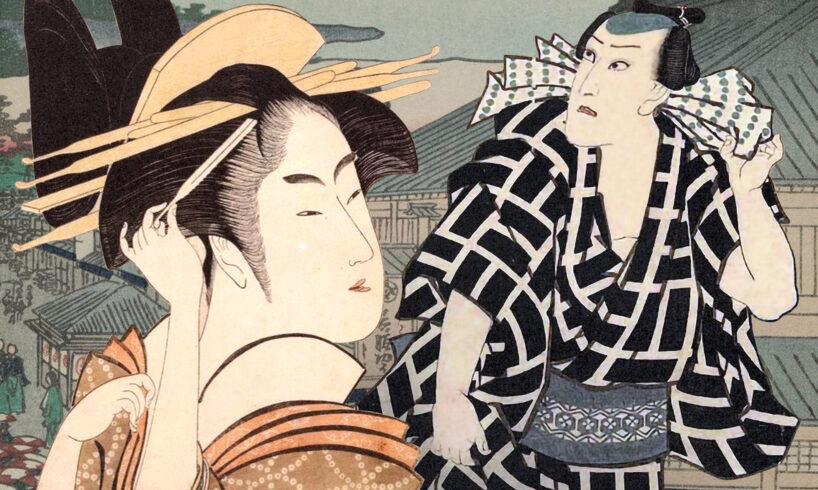
In the early 17th century, Tokugawa Ieyasu concluded his unification of Japan, ending the bloody Sengoku period and allowing the people of Edo — modern-day Tokyo — to focus on the really important stuff: defining what exactly made a person “cool.” It took them a while, but by the 18th century, the Edokko, natives of the biggest city in Japan and also the world, had finally cracked it.
A typical Edokko man, depicted in “Hautanoshin” by Utagawa Kunisada
An Unattainable Ideal
After over a century of thought, the Edokko decided that what made a person “cool” was … being an Edokko. What an amazing and lucky coincidence for them. Of course, not everyone from Edo counted as a true native son of the city. So, what defined an ideal and therefore cool Edokko? Initially, it was “being unlike those old fogeys in Kyoto and Osaka.”
The image of a true citizen of Edo was first defined as the opposite of the aristocrats of Kyoto and the financiers of Osaka. While they were ancient and traditional and safe and cautious, an Edokko was modern, exciting, open to new ideas, fast in speech and always on the go. The city’s boisterous merchant culture contributed greatly to this emerging Edokko identity. With time, the idea evolved slightly, until it wasn’t enough to just NOT be from Kyoto and Osaka; you also couldn’t have any traces of the countryside. An Edokko was urbane. His greatest enemy was the uncool country bumpkin (called a yabo).
“Edo coolness” was thus primarily defined not by what it was, but by what it wasn’t. Popular sharebon (witty books) sometimes presented an impossibly perfect specimen of a chic Edokko that you should try to imitate (but could never become), but primarily focused on anti-role models. Santo Kyoden’s Edo Umare Uwaki no Kabayaki (1785), a fictional story about the son of a wealthy Edo merchant trying to become “cool,” is a humorous list of things not to do. Chief among them was EFFORT. Trying to be cool was the most uncool thing imaginable. It was all part of the tsu/iki philosophy.
Page from Santo Kyoden’s “Edo Umare Uwaki no Kabayaki” storybook (1785)
Tsu, Iki and Other Useful Terminology
“Iki” and “tsu” are two words that came to define the ideals that later Edokko should strive for, even if both of them are kind of hard to define. However, very broadly, “iki” and “tsu” are aesthetic principles tied to (but not strictly defined by) ideas of aloofness, subdued displays of emotion, fashion and wealth (though stinginess was extremely uncool), and a kind of insider knowledge of Edo. At least, that’s what all the sharebon that acted as insider guides to Edo said. Again, what an amazing and lucky coincidence for them!
The difference between iki and tsu has been debated for centuries. The current consensus seems to be that iki is more abstract and ingrained while tsu is more specific, learned and applied to people. It can even be used like this: “A group of tsu are out on the town.” It kind of works like “dandy” in that sense. But that wasn’t always the case. Historically, tsu was more closely connected to the “insider knowledge” part of the makeup of an Edokko, to the point that it basically became a synonym for “guide” in feudal Japan. In many instances, though, iki and tsu have been and continue to be treated like synonyms.
Further roadblocks on the path to understanding iki and tsu are the writings of Nishiyama Matsunosuke, who described such sub-iki/tsu qualities as hari (strength of character, being uncompromising and always staying cool under pressure), bitai (unspoken but burning eroticism/charm without vulgarity; feminine trait), and akanuke (urbane, refined sophistication without arrogance). A fashionable Edokko had to keep all of that in mind while dressing or conducting themselves. Being cool in feudal Japan was a full-time job.
An Exclusive (but Surprisingly Progressive) Club
The “understated” undertone running through iki, tsu, hari, bitai and akanuke stems from Edo’s culture of commoners with lots of disposable income. The city merchants may have been low on the social ladder (technically below peasants because they at least grew rice), but they had a lot of spending power. Combined with laws that forbade displays of luxury for commoners, this resulted in a singular idea of strategic simplicity that hinted at how chic a person was but was only perceivable to equally cool Edokko in the know. It was like belonging to a secret club.
And it was an extremely select club. As mentioned before, a country mouse could never be “cool.” Edo laborers may have had the right pedigree and state of mind to achieve iki and tsu, but they were usually too poor to afford, say, a stripy, smoky-light-brown garment with some tasteful blue lining (the perfect iki/tsu attire). Samurai were almost universally “uncool.” Even the poorest ones in tattered kimono still carried two swords with them, which were outward symbols of their status. There was nothing iki/tsu about them, unlike some Edo women.
The prostitutes of the Yoshiwara red-light district, who lived one day at a time (since they often died young), were considered the epitome of hari and had perfected the art of bitai coquettishness — but maybe sometimes dressed too flashily. Female geisha (as opposed to the original male ones), on the other hand, possessed specialized knowledge of the arts and were held up as icons of subdued chic. A number of writers considered all women unable to achieve iki/tsu because of their emotions, but many aspiring Edo dandies apparently looked at some of the city’s women as role models.
Related Posts
Discover Tokyo, Every Week
Get the city’s best stories, under-the-radar spots and exclusive invites delivered straight to your inbox.
Updated On September 30, 2025





